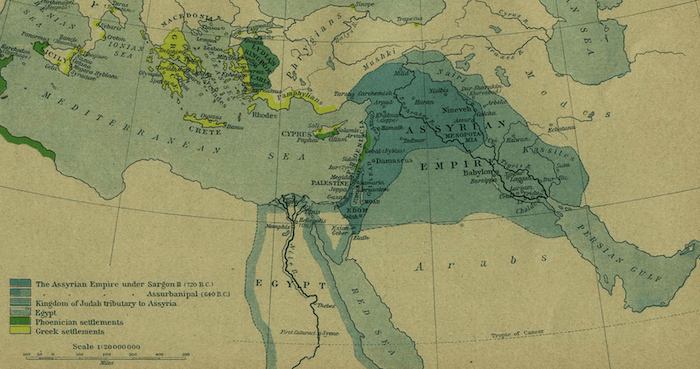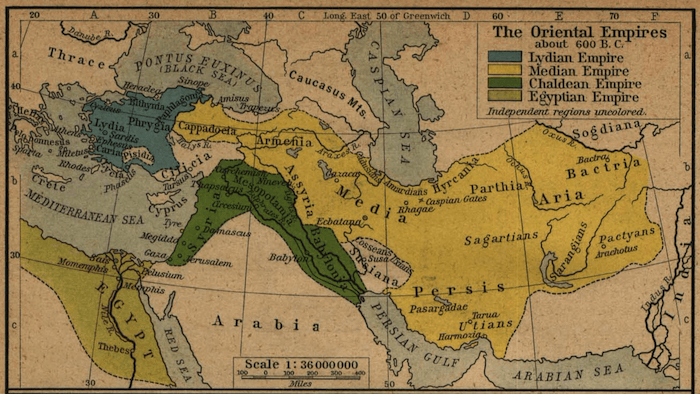Cultures > Urartu
Urartu
Background
Urartu is the name of a kingdom that was centered between the Black Sea and the Caspian Sea. It was first mentioned by the Assyrians around 1300 BC and between 900 BC and 800 BC it grew in political power and economic wealth.
Origins
The Urartians called their country Biainili and their capital was located at Tushpa. They are believed to be related or descended from the Hurrians or the Hittites and their culture greatly adopted elements from the Assyrians as well. Urartu was located in the mineral rich Taurus Mountains where they mined the natural resources.
Urartu, ancient country of southwest Asia centred in the mountainous region southeast of the Black Sea and southwest of the Caspian Sea. Today the region is divided among Armenia, eastern Turkey, and northwestern Iran. Mentioned in Assyrian sources from the early 13th century BC, Urartu enjoyed considerable political power in the Middle East in the 9th and 8th centuries BC. The Urartians were succeeded in the area in the 6th century BC by the Armenians.The Assyrian influence was manifested in two phases: first, from about 1275 BC to 840, when the Assyrians campaigned in Urartian territory and met only scattered resistance; and second, from 840 to 612, during the heyday of the Urartian kingdom. In the first phase, Assyrian influence was felt directly, and the local inhabitants were helplessly exposed to ruthless depredation at the hands of the Assyrians. During that time, the Urartians seem to have eagerly absorbed or imitated the amenities of Assyria’s higher civilization. In the second phase, Urartu produced its own distinctive counterparts to all Assyrian achievements.The first century of the new kingdom seems to have emphasized military operations in imitation of Assyria, and Urartu waged relentless warfare on its neighbours to the east, west, and north.For the reign of Sarduri I (c. 840–830 BC), there remain only the inscriptions at Van. But for the reigns of his son Ishpuini (c. 830–810) and especially of Ishpuini’s son Meinua (c. 810–781), Urartian conquests can be measured indirectly from widespread inscriptions ranging from the lower Murat River basin (around Elâziğ) in the west to the Aras (Araks, Araxes) River (i.e., from Erzurum to Mount Ararat) in the north and to the south shore of Lake Urmia in the southeast. Ardini, or Muṣaṣir, once conquered by Tiglath-pileser I of Assyria about 1100, now became part of the Urartian sphere of influence. The temple of Haldi at Ardini was richly endowed by the Urartian kings but was open to Assyrian worshipers.A number of Urartian inscriptions dealing with religious subjects date to the end of Ishpuini’s reign. It seems that the state religion received its established form at that time, and the hierarchy of the many gods in the Urartian pantheon is expressed by a list of sacrifices due them.The first evidence of engineering projects, designed to increase the productivity of the home country by irrigation, dates to the reign of Meinua. That is the “Canal of Meinua,” which led—and still leads—fresh water over a distance of about 28 miles (45 km) from an abundant spring to the southern edge of Van.From the reigns of Meinua’s son Argishti I (c. 780–756) and grandson Sarduri II (c. 755–735) there is, in addition to inscriptions, a direct historical source in the form of annals carved into the rock of Van and into stelae that were displaced in later times to other locations in the vicinity. Under those kings, Urartu thrust out westward to the great bend of the Euphrates River and intermittently beyond, toward Melitene (modern Malatya) and the ancient Syrian district of Commagene, thus cutting off one of the main supply roads by which Assyria obtained essential iron from the western Taurus Mountains. Argishti I subdued the Melitene Hilaruada (c. 777), as did Sarduri II in the 750s. King Kushtashpi of Commagene was subjugated by Sarduri II about 745. Part of the domain of King Tuate of Tabal in the Taurus Mountains had also fallen to Argishti I about 777. For a short time Urartu thus had a bridgehead west of the Euphrates from Malatya to Halfeti (ancient Halpa) in Commagene, and its empire reached to within 20 miles (32 km) of Aleppo in northern Syria.Argishti and Sarduri also embarked on what was in the end to prove the most fruitful of all Urartian ventures: the conquest and subsequent agricultural exploitation of the regions across the Aras River. Under Argishti I, Diauehi (“the Land of the Sons of Diau”; Assyrian: Daiaeni) was finally defeated, and the upper and middle Aras River valley became a major centre of building, irrigation, and agricultural activity. Sarduri added Lakes Çildir and Sevan. Further advance to the northwest was checked by a new adversary, the kingdom of Qulha (Greek: Colchis). The tens of thousands of prisoners taken on the yearly military campaigns (in one year as many as 39,000) provided the manpower for intensive cultivation of the royal estates and processing of their crops.Several times the Urartian kings of that period claimed, probably with justification, to have defeated Assyrian armies: Argishti reported victories over the Assyrians in his sixth and seventh regnal years, when he operated in the Zab and Lake Urmia areas; and Sarduri II defeated the Assyrian king Ashur-nirari V in the upper basin of the Tigris River about 753.Assyrian Empire
The conquest of Urartu began in the 8th century BC under the reign of Tiglath-Pileser III who defeated king Sarduri II in Commagene near the city of Halfeti. Tiglath-Pileser III was able to bring the Assyrian army all the way to the gates of Tushpa and there was a revolt within the Urartu political system and this saw Sarduri's son Rusa I (735-713 BC) take the throne. Sargon II was able to make gains against Urartu by conquering their allies such as Carchemish in 717 BC. Other allies that would be conquered were Tabal which was a Neo-Hittite nation. Urartu was a great competitor to the Neo-Assyrian empire and they would never be full conquered.

Assyrian Empire Map (750-625 BC) - Historical Atlas (1923)
What did lead to a decrease in their political and military power however, was the invasion of the Cimmerians that occurred in 714 BC. Some believe this is because Urartu had collapsed the states to the north but did not secure them allowing the Cimmerians to settle right up their borders. The forces of Rusa I rode out to meet the Cimmerian invaders and according to Sennacherib who was gathering intelligence about the kingdom at the time under Sargon they were crushed completely. Rusa I was forced to flee back to Urartu and resulted in a great defeat for their military.
The Assyrians took advantage of this period and launched a military campaign of their own in 714 BC that would decimate the political power of Urartu for good and they would never become anything other than a small territorial power. They were never fully conquered by the Assyrians but they were pushed back. Instead of pursuing the forces to Tushpa the Assyrians plundered the city of Ardini and looted the great statue of Haldi. Upon hearing this Rusa I committed suicide and his son Argishti II (712–685 BC) took over rule of Urartu.
Median Empire
While retaining some independence in their pursuit of natural resources eventually the kingdom of Urartu would be conquered by the Median Empire.

Mesopotamian Empires 600 BC - Historical Atlas (1923)